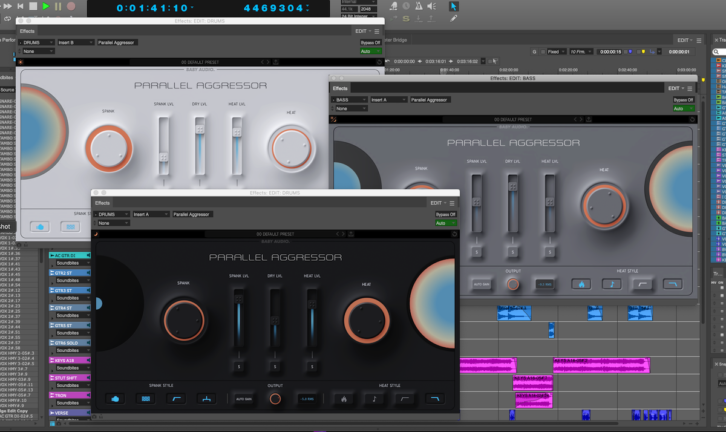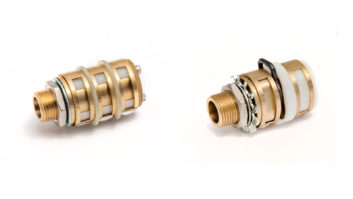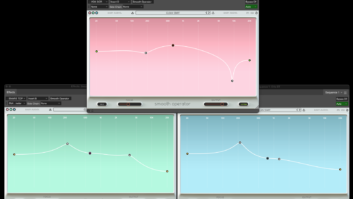
At first, I wanted to be sure I had the basics covered with premium plug-ins for all my requisite EQ, dynamics and time-based effect work. Now that those bases are covered, all I seem to desire anymore are quirky, non-traditional and lightning-fast workflow enhancers—plug-ins like the new Parallel Aggressor from BABY Audio.
Out of the Box
Parallel Aggressor (PA) is basically a saturation/distortion plug-in that accomplishes parallel processing with two different processors, Spank and Heat.
If Spank’s processing sounds familiar, there’s a good reason, as it’s actually the sound of the classic dbx 163 single-slider, super-budget compressor as digitally virtualized by BABY Audio’s I Heart NY parallel-compression plug-in. The 163 was my very first compressor, so many moons ago…. (sigh.)
If Heat’s processing sounds familiar, you’re likely a long-in-the-tooth veteran of the not-so-good-old analog days when we would print stereo audio to cassette or VHS tape for their “high fidelity,” only to find that it distorted in a surprisingly juicy manner when overdriven; this sound is digitally virtualized by the sound of BABY Audio’s Super VHS plug-in.
PA has a fader and solo button for dry signal, Spank and Heat as well as Auto Gain, and an output level control to achieve balance and enable wise comparisons. Both Spank and Heat each have an intensity control that decides their tone even more than the four Style button controls per processor.
The Spank side has an Extra Punch button (adds some attack), Extra Smack (brings up some high-mids), Sidechain Filter (filters out some bottom from the detector) and Mono. The Heat side offers Extra Hot (adds a little more distortion), Tone (adds some mids), HP Filter (filters some bottom off the actual signal, not the side chain) and LP Filter (which can take some nasty high-end off of buzzy distortion).
Spank’s 163-inspired response ranges from a nice, warm congealing and smoothing, to a bold grabby and chesty thing (characterized by that trademark 163 attack), all the way to a pumpy, growly super-squash that is best suited to parallel uses for sure. Heat ranges from a slight increase in detail edge and definition to a sizzly solid-state-ish buzz, all the way to an over-the-top, full-on distortion that is quite recognizable as the tape-slammed-all-to-hell variety.
The metering for process intensity presented as an orange ring around each control; the amounts of each process are the big hemispheres far left and right.
Shure Beta91A Condenser Boundary Microphone – A Real-World Review
In Session
There are a lot of different ways to use saturators in general and PA, with its dual-processors and abundant control, offers tons of flexibility beyond the norm, so pardon me if I only summarize operations. Suffice to say, you can go easy on both Spank and Heat intensity, and blend them in subtly for an increase in size, detail and apparent “quality” that is perfect for mixes without being at all self-evident. I used light Spank, with Extra Punch (optional) and Sidechain Filter mixed about -12 dB under my dry signal, and with very-light Heat (no filters) mixed at least -12 dB down if not more.
Sub-groups like drums and basses benefit from moderately aggressive use of both Spank and Heat, whereas guitars, keys and vocals require a little more restraint. I found myself typically using Extra Punch and Extra Smack for the aggression and bite, with Sidechain Filter and Mono both in to increase bottom-end response and avoid losing any thump. Extra Hot, Tone and HP Filter all helped increase detail and aggression on the Heat side, with the LP Filter proving essential at taking enough spiky aggression off to allow bolder usage. Guitars and vocals required the most sensitive touch, drums allow the most flexibility and the only question is which subgroups don’t get PA’d (don’t saturate everything in a mix, tempting though it may be).
Individual tracks allow the most fun with PA, especially the Heat side, which can be “too much” pretty easily. Vocals can take the Heat, as can guitar solos, gnarly bass monsters (of the stringed or synth variety), oversized synths and industrial-ized snares. It’s all great, addictive fun; just make sure to experiment with those Style buttons when listening to your tracks in the whole mix, not in solo. I liked just about all the options PA gave me when soloed, but the question is what works in the big picture.
The Final Mix
Parallel Aggressor offers plenty of versatility to avoid any “one trick pony” issues and still manages to be a “quick fix” with a limited number of powerful controls. There are a lot of effective plug-ins available today for saturation and distortion tasks, but few offer the convenient use of each, with a full complement of variables, in such a convenient package and full parallel mixing abilities on-board. At this price of $49, I can think of no other, actually.
BABY Audio • https://babyaud.io







